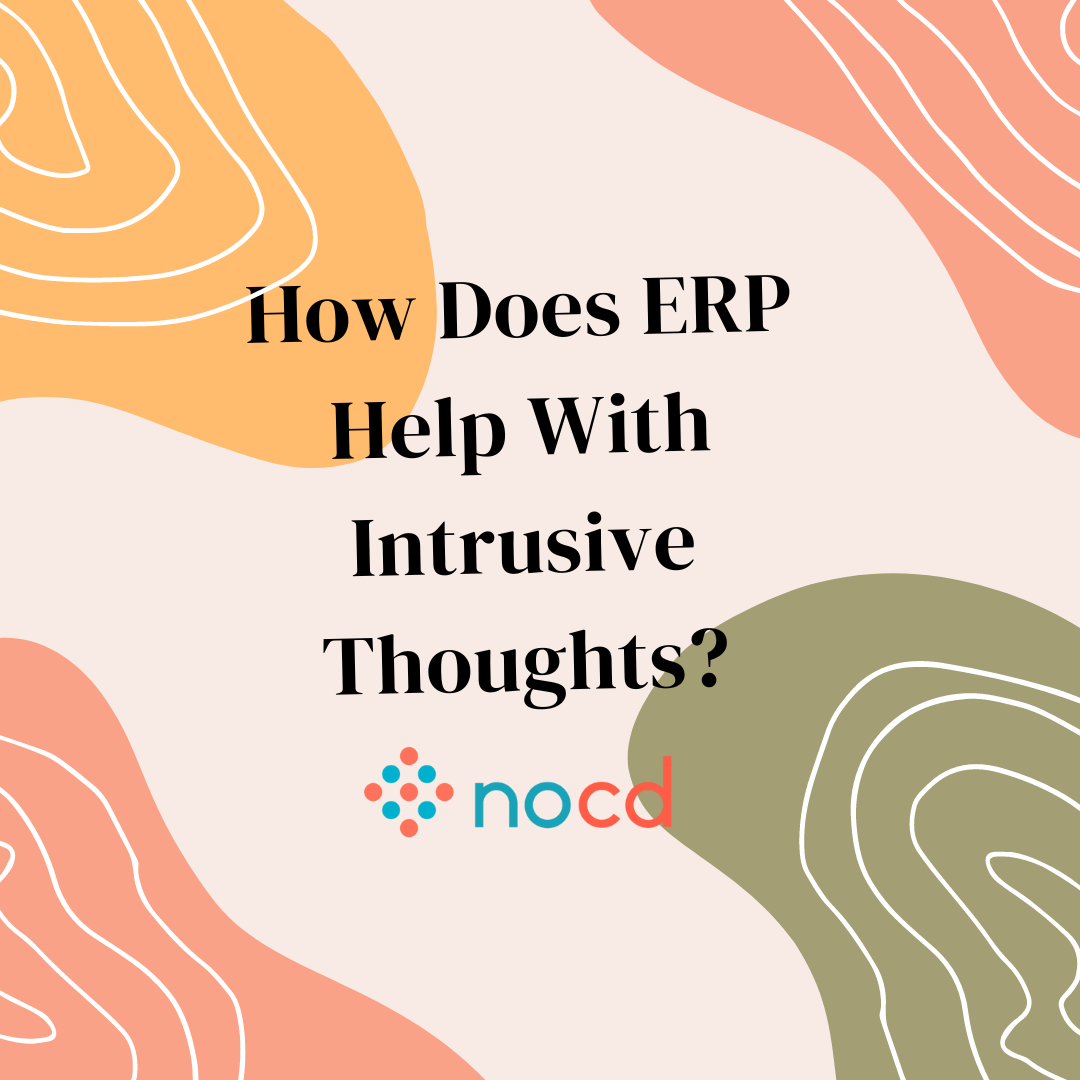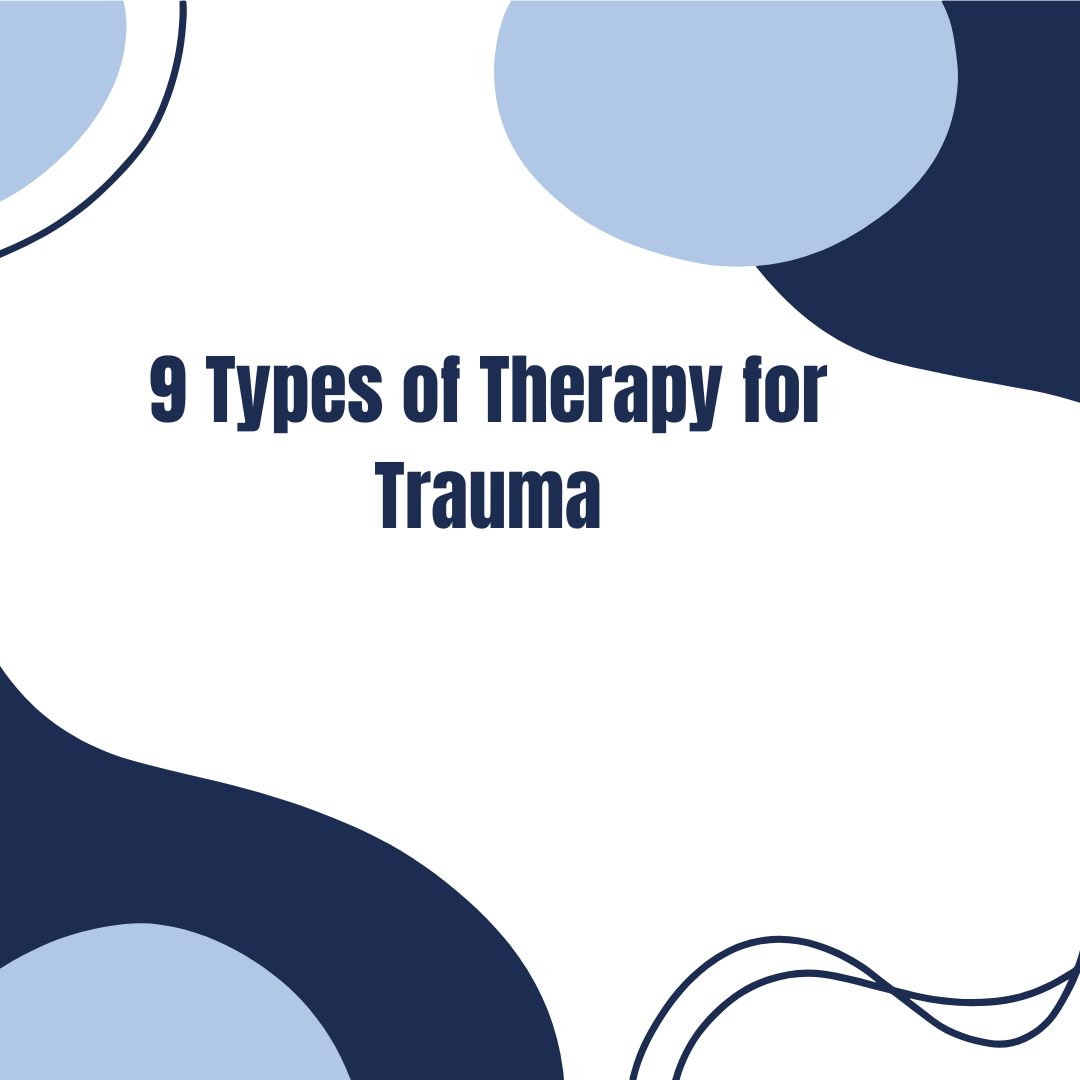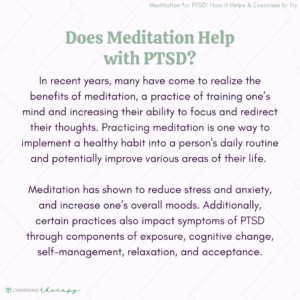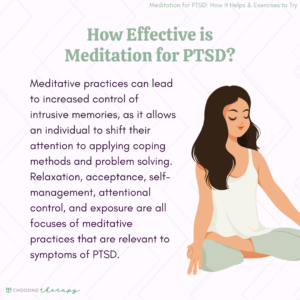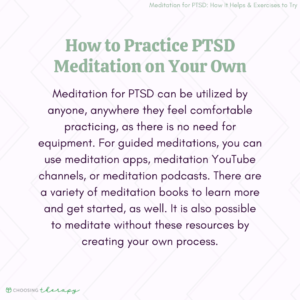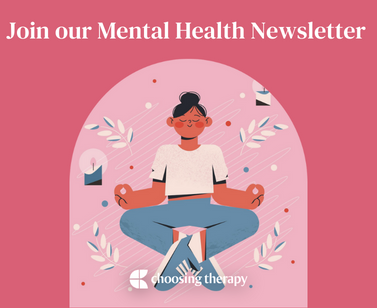
Meditation for Post-Traumatic Stress Disorder (PTSD) is considered a complementary and alternative medicine (CAM), and has been found to help relieve symptoms by lowering stress, improving mood, and reducing intrusive thoughts.1 Using meditation in conjunction with psychotherapy has been found to have comparable effects to medications. With that mentioned, meditation could be a considerable supplemental treatment option to traditional treatments for PTSD.1
Online Therapy For PTSD Therapy can help you live a better life. BetterHelp provides convenient and affordable online therapy, starting at $65 per week. Take a Free Online Assessment and get matched with the right therapist for you!
What Is PTSD?
PTSD can be developed by anyone who is exposed to an event that can be perceived as stressful or traumatic. The event can happen directly to the person, or they could witness or hear about it happening. Such instances could include cases of domestic violence, emotional abuse, unhealthy relationships, sexual abuse, natural disasters, war or combat, and car accidents. Some signs of PTSD may include anxiety, depression, isolation, irritability, and sleep disturbances, among others.
The four categories of PTSD symptoms include:
- Intrusive memories & reliving the trauma: Intrusive memories can look like an interruption of thoughts with memories related to the event. This can trigger feelings that make it feel like the person is reliving the traumatic event all over again in the form of PTSD flashbacks.
- Hypervigilance: This state of mind tends to look like an increased state of being alert, and impacts a person’s thoughts, feelings, and behaviors
- Avoidance: Avoidance can include one’s efforts to avoid thoughts, feelings, memories, people, places, and activities that may remind the person of their trauma. The person may end relationships, hobbies, or a job to decrease exposure to triggers.
- Negative changes in thinking & mood: Following a traumatic event, people may become more irritable, angry, aggressive, reckless, or impulsive. A person may also have increased difficulty with concentration and falling or staying asleep.
Common Treatment Options for PTSD
The most common treatment options for PTSD include therapy and medication. Typically, for adults with PTSD, it is recommended that trauma-focused psychotherapy be utilized as a first-line treatment, followed by medication.2 For some with PTSD, recovery may occur within six months of beginning a treatment plan. For others, they may battle symptoms related to PTSD for the rest of their lives.
Therapy
Psychotherapy, otherwise known as “talk therapy”, can help those with PTSD in individual or group therapy sessions. Therapy that includes evidence-based modalities is believed to be a more effective treatment than medication.1 When a person is talking about their traumatic experience, a flight or fight response may arise. In those moments, the therapist can teach the person how to manage those symptoms individually.1This can help the person apply what they learn during therapy sessions to their daily lives.
Therapy options for PTSD include:
- Cognitive behavioral therapy (CBT): CBT for PTSD challenges unhealthy thought processes and emotions that are linked to a person’s trauma, and teaches a person how their thoughts are linked to their behaviors.
- Dialectical behavior therapy (DBT): DBT for PTSD works because it can teach individuals how to cope with triggers and navigate through various areas of their lives.
- Eye movement desensitization & reprocessing (EMDR): Dual attention stimuli (DAS) used in EMDR desensitizes the traumatic content of a memory. EMDR for PTSD works because DAS decreases the impact of many common PTSD symptoms.
- Hypnosis: Hypnosis for PTSD is beneficial because techniques are utilized by the therapist that guide a person towards healthy resolution through relaxation and aversion therapy.
- Prolonged exposure therapy: Imagery and literature related to or physically going to the location where the trauma event occurred may be used to expose a person to their triggers, helping them confront and control their fears.1 This type of therapy safely allows the person to talk about the details of their experience.
Medication
A number of different types of PTSD medications may be prescribed to address symptoms, including anti-anxiety medications, antidepressants, and mood stabilizers. If a person chooses to take medication, it is suggested that medication be utilized in conjunction with psychotherapy. Medication works by targeting a person’s neurotransmitters, which reduces some of the symptoms associated with PTSD.
Help For Trauma / PTSD Talk Therapy – Get help recovering from trauma from a licensed therapist. Betterhelp offers online therapy starting at $60 per week. Free Assessment Online PTSD treatment – Talkiatry offers personalized care from psychiatrists who listen and take insurance. Get matched with a specialist in just 15 minutes. Take our assessment
Does Meditation Help With PTSD?
In recent years, many have come to realize the benefits of meditation, a practice of training one’s mind and increasing their ability to focus and redirect their thoughts.1Practicing meditation is one way to implement a healthy habit into a person’s daily routine and potentially improve various areas of their life.
Meditation has shown to reduce stress and anxiety, and increase one’s overall moods.1 Additionally, certain practices also impact symptoms of PTSD through components of exposure, cognitive change, self-management, relaxation, and acceptance.1
Types of meditation that are helpful for treating PTSD include:
Mindfulness Meditation
Learning to change the course of one’s thoughts and overcome the negative associations with them begins first with awareness; this allows a person to accept, cope with, and redirect their thoughts.
Grounding techniques can assist a person in becoming more present and cognitive of what they are thinking and how they are feeling in the moment. Mindfulness is a technique that falls into this category, and focuses on remaining present, aware, and accepting of one’s current thoughts, feelings, and bodily sensations. Mindfulness based stress reduction includes a number of specific techniques that include coping with stress, chronic pain or illness, anxiety, and depression. Examples of this include describing objects around you; using your five senses; creating a safe space in your mind through guided imagery; visualizing your anxiety; and using affirmations.
Focused Meditation
Focused meditation involves focusing on a specific sound or sensory experience to stay present. If the mind wanders during meditation, the practitioner simply returns to their focal point to bring themselves into the present moment.
Mantra Meditation
Mantras may be a sound, a single word, or a phrase repeated silently or out loud, and is used by incorporating these into one’s typical meditation practice. Mantra meditation is usually performed within a comfortable and quiet space, where someone can sit, lay down, stand or walk. They can then close their eyes or focus on a certain object, bring awareness to their breath, take a few deep breaths, and begin either thinking or speaking their manta out loud once or repeatedly.
This can be helpful for PTSD, because it can ground one’s mind to the present moment and cultivate focused control.1 For example, when having a flashback, experiencing hypervigilance, hyperarousal, anxiety, or feeling irritable, one may repeat to themselves “I am present, I am here, I am safe,” or “I am not my trauma, peace is within me.” They can also create their own mantra, and affirm to themselves a word or phrase that they believe will ease their PTSD symptoms. This may take some trial and error until they discover what works best for them in their heightened moments.
Loving-Kindness Meditation
Loving-Kindness Meditation is a practice that is included in mindfulness-based stress reduction (MBSR) and is sometimes called “metta” meditation.4 This type of meditation places emphasis on kindness by creating feelings of connectedness by utilizing mantras. This can lead to an increase in one’s positive reactions to people and things around them, as well as satisfaction within relationships.4
Loving-kindness meditation shifts one’s focus from themselves and onto other people, which may result in decreased PTSD symptoms like anxiety and depression. Evidence shows that various populations who consistently practiced experienced promising results including an increase in positive emotions, greater life satisfaction, and improved interpersonal interactions. Moreover, in comparison to before they began practicing this form of meditation, they also reported improved self-reassurance, decreased anxiety and depressive symptoms, and reduced self-criticism and psychological distress.4
Journaling or Writing for PTSD
Writing about a traumatic or difficult experience may sound counterintuitive. However, this can be helpful, as it gives the writer power over their own life and experiences. As previously discussed, PTSD impacts the brain’s processing system following a traumatic or stressful event. When writing and narrating the story of the past experience, a person’s brain may better reorganize the way the event is perceived in the brain.5 An individual does not have to be good at writing to journal about their experience–all that is needed is pen, paper, and a willingness to be open about your experience. It is suggested that someone tries working with a licensed mental health professional, so a therapist can support and guide them through thoughts and emotions that come up during this process.
Online Therapy For PTSD Therapy can help you live a better life. BetterHelp provides convenient and affordable online therapy, starting at $65 per week. Take a Free Online Assessment and get matched with the right therapist for you!
How Effective is Meditation for PTSD?
Meditative practices can lead to increased control of intrusive memories, as it allows an individual to shift their attention to applying coping methods and problem solving.1 Relaxation, acceptance, self-management, attentional control, and exposure are all focuses of meditative practices that are relevant to symptoms of PTSD.1
One study found that practicing meditation or yoga had small to medium effects on PTSD symptom reduction.1 Furthermore, their findings were comparable to the use of medication for treatment of PTSD, which is a recommended second-line treatment for PTSD.1 This may indicate that psychotherapy in conjunction with complementary and alternative medicine options, like meditation, could lead to similar outcomes of other second-line treatment options.
How to Practice PTSD Meditation on Your Own
Meditation for PTSD can be utilized by anyone, anywhere they feel comfortable practicing, as there is no need for equipment. For guided meditations, one can use meditation apps, meditation youtube channels, or meditation podcasts. There are a variety of meditation books to learn more and get started, as well. It is also possible to meditate without these resources by creating your own process.
Here is one way to start practicing meditation on your own:
- Find a comfortable and quiet area to sit, stand, or lay down.
- If it is safe to do so and you are comfortable, close your eyes or focus on an area in front of you.
- Begin to notice and focus on your breath; feel the air flow in through your nose and out through your mouth.
- Notice the rising and falling of your belly as you breathe in and out, and how your body feels, the seat against your body, or your feet touching the floor.
- If any thoughts pop up, allow them to flow and pass; do not judge the thoughts or create meaning out of them. Accept them as they are and gently bring your focus back to your breath.
- Affirm to yourself, “I am safe, I am present, I am not my trauma,” or come up with your own mantra for this meditation.
- Turn your focus back to your breath and continue your mantras as you need throughout your meditation.
- As you take your final three deep breaths–slowly in through your nose and out through your mouth–pick an affirmation you want to carry with you for the remainder of the day.
- Bring your attention back to your body sensations and when you are ready, gently open your eyes. Observe your surroundings and take a few gentle stretches.
- Carry your affirmation with you (by writing it down or mentally making note of it) and allow the sense of calmness that you created within the meditation to guide you throughout your day.
Additional Complementary & Alternative Treatments
Meditation may not be for everyone, but sometimes what may feel awkward or uncomfortable the first few times can become helpful with practice. If you have only tried one type of meditation once before, it’s suggested to try again or maybe another form.
Here are some additional complementary and alternative treatments for PTSD:
- Yoga for Anxiety
- Chiropractic Care
- Massage
- Naturopathic Medicine
- Biofeedback
- Exercise for Mental Health
- Tai Chi
- Supplementation
- Herbalism
How to Find a Mental Health Professional
It can be difficult to find the right therapist or mental health professional. However, there are a number of sources that make this process a bit easier. Certain organizations provide information and resources on mindfulness-based cognitive therapy (MCBT), and international listings of mental health professionals who utilize MBCT in their practice. Online therapist directories allow you to search based on therapist specialty, state, and insurance. It is also possible to select what specific issues you are having, and what kind of therapy you are searching for.
Final Thoughts
If PTSD symptoms are negatively impacting your life, it may be beneficial to seek additional therapy to help treat your symptoms. Meditation and other CAMs have shown to be beneficial as a second-line treatment option to psychotherapy. Regular practice can help relieve PTSD symptoms including stress, mood, and intrusive thoughts. With similar results to medication as a complementary treatment, meditation may be a worthy supplemental treatment option.1 It is encouraged to incorporate meditative practices in all areas of one’s life–not just in response to a trauma trigger, as this increases the likelihood of someone utilizing the techniques.1
To help our readers take the next step in their mental health journey, Choosing Therapy has partnered with leaders in mental health and wellness. Choosing Therapy is compensated for marketing by the companies included below. Online Therapy BetterHelp – Get support and guidance from a licensed therapist. BetterHelp has over 20,000 therapists who provide convenient and affordable online therapy. Complete a brief questionnaire and get matched with the right therapist for you. Get Started Psychiatry, with you in mind Talkiatry – Our Psychiatrists Can Diagnose Your Condition, Prescribe Medication, And Monitor Your Progress. Most psychiatry visits cost patients $30 or less* Free Assessment Psychedelic Therapy Nue.life – Healing is personal. So is our accessible, evidence-based approach to psychedelic therapy. At-home ketamine Therapy For Depression, Anxiety, and Trauma. Real healing. Real science. Discover our evidence-based psychedelic approach. Visit Nue.Life Mental Health Newsletter A free newsletter from Choosing Therapy for those interested in meditation & mindfulness. Get helpful tips and the latest information. Sign Up Choosing Therapy Directory You can search for therapists by specialty, experience, insurance, or price, and location. Find a therapist today. *Includes copayment, deductible, coinsurance, and $0 Visits. Excludes no shows.Additional Resources
For Further Reading
How Does ERP Help With Intrusive Thoughts? Obsessive compulsive disorder (OCD) is a psychiatric condition marked by the presence of obsessive thoughts, images, doubts, or urges, followed by compulsive behaviors or acts aimed at easing the distress caused by the obsession. While the content of the obsessions can take many forms, they are always repetitive, persistent, involuntary, and intrusive, and they often result in a great deal of anxiety for the person experiencing them. 9 Types of Therapy for Trauma Experiencing trauma can result in distressing and debilitating symptoms, but remind yourself that there is hope for healing. If you or a loved one is suffering from the aftereffects of trauma, consider seeking therapy. Trauma therapy can help you reclaim your life and a positive sense of self. 